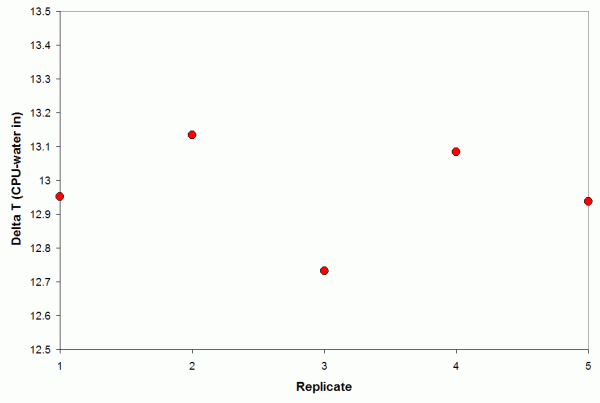|
|
|
|
 Danger Den Maze 4 Review Danger Den Maze 4 Review
|
|
Date Posted: Apr 10 2004
|
|
Author: pHaestus
|
|
|
|
|
Posting Type: Review
|
|
Category: H2O and High End Cooling Reviews
|
|
Page: 1 of 1
|
|
Article Rank:No Rank Yet
Must Log In to Rank This Article
|
|
|
|
|
Note: This is a legacy article, imported from old code. Due to this some items on the page may not function as expected. Links, Colors, and some images may not be set correctly.
|
|
|
Danger Den Maze 4 Review By: pHaestus
|
|
|
Dangerden Maze 4 Review
By: pHaestus 4/10/04
|
|
|
The Dangerden Maze4 is a copper base multiple channel design that features a Lexan top and two barbs arranged so water flows side to side through the
block. This was a large change from previous Dangerden designs as the Maze 1C, Maze 2rev2, and Maze 3 all relied on some variation on a center inlet/spiral channel design. In fact, the Maze4 in design represents the
largest change from Dangerden since they switched to a spiral channel design from the original labyrinthine Maze 2 (my first waterblock, by the way). Here's what Dangerden said about the design:
"The MAZE4 was designed up to be one of the
lowest flow restrictive blocks on the market and to provide better cooling then the MAZE3. The design was to also improve the mounting of the Lucite top and cold plates to the block.
These improvements also lead to a smaller profile and lower overall weight block."
Jeremy Burnett of Dangerden
The Maze4 was provided by Cooltechnica, and so it should be representative in finish and performance of Dangerden's
retail waterblocks. The quality of the machining on both the Lexan top and copper baseplate is very high; Dangerden's machinists obviously know what they are doing.
The Maze4 uses nylon barbs rather than brass or stainless steel ones, presumably to minimize the chance that the top will crack when barbs are tightened. The baseplate finish could benefit from lapping.
|
|
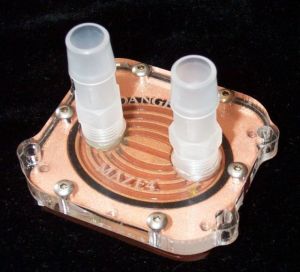 |
|
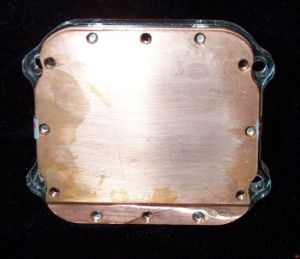 |
|
|
|
|
Test Results and Observations
|
|
Testing methods are the same as used in earlier waterblock reviews. One new development is the estimation that my
TBredB 1700+ at 13x175fsb and 1.85V (BIOS) generates approximately 73W under load. I am hesitant to convert the graphs from deltaT to C/W as of yet (still playing with this sort of W estimation), but that should give you a ballpark number for CPU power.
Rather than use the included springs from Dangerden, I used the same mounting hardware used in RBX, Whitewater, and Cascade testing.
The first test I conduct is the variation of waterblock performance over many mounting replicates at 1.50 GPM flow rate. .
|
|
I only mounted the Maze 4 5 times because the standard deviation from those mounts (0.156C) was absolutely stellar. Since my MCW5000-A testing
also showed a decrease in standard deviation, I suspect my thermal paste application methods must be slowly improving.
The next test conducted is the relationship between waterblock performance and flow rate:
|
|
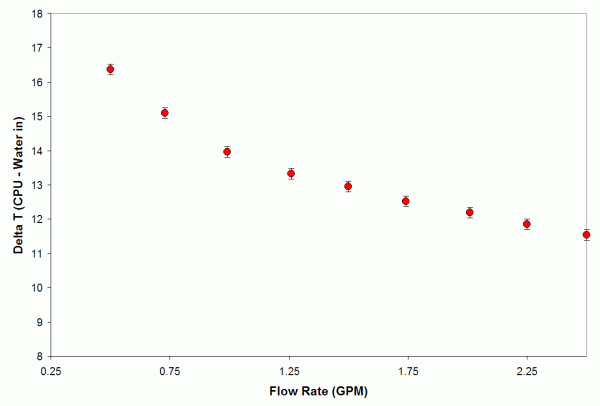 |
|
The Maze4's performance at flow rates below 1GPM is quite poor, and at flow rates 1GPM and above there is a continuous increase in performance as
flow rates increase.
The continued improvement in performance is similar to the curves observed with thin baseplate/die impingement blocks like the RBX and whitewater, but I do not believe they result from the same physical processes. In the thin baseplate blocks there is a reliance on high water velocity at the central inlet to transfer heat because there is very little heat spreading. The differences in design between Cascade, RBX, and Whitewater basically amount to different approaches in optimizing water velocity/baseplate thickness for CPU cooling. With the Maze 4, though, there is a thicker baseplate and no die impingement. Instead, there is a fairly large amount of copper directly over the core and hemispherical channels in which for water to travel. I suspect that the central cooling paths are by far the most important in heat transfer, and that increasing flow rates improves block performance by simply increasing turbulence in those channels.
The Maze4's performance is more easily compared with other waterblocks when they are all graphed on the same Delta T vs. Flow rate graph:
|
|
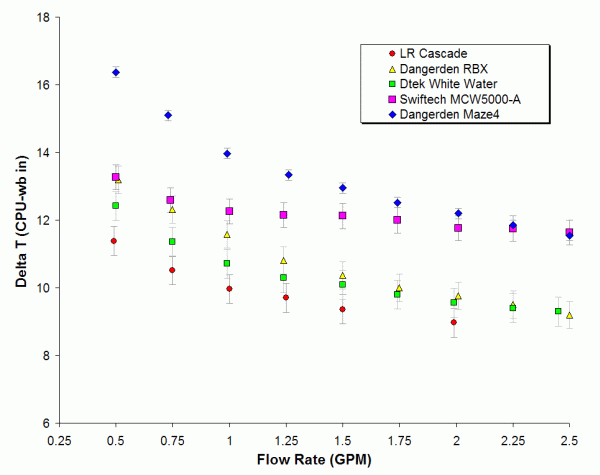 |
|
This graph is becoming less and less useful as I test waterblocks of widely differing design. The reader's instinct is to say the Maze4 is "a
bad block" or that the Cascade is "best".
The dT vs. Flow rate graph only tells one half of the story, though. In my test loop with fully open valves, I could push 3.25GPM through the Maze4, and only 2.15GPM through the cascade. This means that the Maze4 has a much smaller resistance to flow, and that an end user cooling only a CPU with a typical pump (Eheim 1250, Hydor L30) and a ½" loop could expect flow rates in the 2GPM+ range for the Maze4, and in the 1-1.5GPM range for the Cascade. This typical user would see more like a 2-3C performance difference rather than the 4-5 you'd expect by comparing all the blocks at an identical flow rate. I freely admit that I need to produce head loss vs. flow rate graphs for the waterblocks I test; this information would allow us to make "apples to apples" comparisons.
One useful piece of information one can pull from the above graph is that the Maze4 is a poor choice for a very low flow rate system.
While the MCW5000-A was "tuned" to be extremely competitive at 0.5-1GPM flow rates, the Maze4 relies on high flow to a far greater extent. I would not suggest using a Maze4 in a loop with multiple blocks, small pumps, or 3/8" ID tubing.
Thanks to Bruce at Cooltechnica for providing the Dangerden Maze4 for testing.
|
|
|
|
| Random Forum Pic |
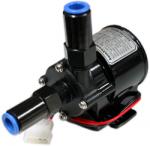 |
| From Thread: Which customized AquaXtreme 50Z-DC12-T Mag Drive Inline Pump setup would you go with? |
|
| | ProCooling Poll: |
| So why the hell not? |
|
I agree!
|
 67% 67%
|
|
What?
|
 17% 17%
|
|
Hell NO!
|
 0% 0%
|
|
Worst Poll Ever.
|
 17% 17%
|
Total Votes:18Please Login to Vote!
|
|






 Danger Den Maze 4 Review
Danger Den Maze 4 Review


